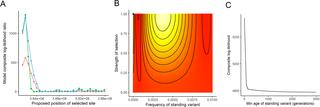当前位置:
X-MOL 学术
›
PLOS Genet.
›
论文详情
Our official English website, www.x-mol.net, welcomes your
feedback! (Note: you will need to create a separate account there.)
Parallel and nonparallel genomic responses contribute to herbicide resistance in Ipomoea purpurea, a common agricultural weed.
PLOS Genetics ( IF 4.0 ) Pub Date : 2020-02-03 , DOI: 10.1371/journal.pgen.1008593 Megan Van Etten 1 , Kristin M Lee 2 , Shu-Mei Chang 3 , Regina S Baucom 4
PLOS Genetics ( IF 4.0 ) Pub Date : 2020-02-03 , DOI: 10.1371/journal.pgen.1008593 Megan Van Etten 1 , Kristin M Lee 2 , Shu-Mei Chang 3 , Regina S Baucom 4
Affiliation

|
The repeated evolution of herbicide resistance has been cited as an example of genetic parallelism, wherein separate species or genetic lineages utilize the same genetic solution in response to selection. However, most studies that investigate the genetic basis of herbicide resistance examine the potential for changes in the protein targeted by the herbicide rather than considering genome-wide changes. We used a population genomics screen and targeted exome re-sequencing to uncover the potential genetic basis of glyphosate resistance in the common morning glory, Ipomoea purpurea, and to determine if genetic parallelism underlies the repeated evolution of resistance across replicate resistant populations. We found no evidence for changes in 5-enolpyruvylshikimate-3-phosphate synthase (EPSPS), glyphosate's target protein, that were associated with resistance, and instead identified five genomic regions that showed evidence of selection. Within these regions, genes involved in herbicide detoxification-cytochrome P450s, ABC transporters, and glycosyltransferases-are enriched and exhibit signs of selective sweeps. One region under selection shows parallel changes across all assayed resistant populations whereas other regions exhibit signs of divergence. Thus, while it appears that the physiological mechanism of resistance in this species is likely the same among resistant populations, we find patterns of both similar and divergent selection across separate resistant populations at particular loci.
中文翻译:

平行和非平行基因组反应有助于常见农业杂草紫薯的除草剂抗性。
除草剂抗性的重复进化被引用为遗传平行性的一个例子,其中不同的物种或遗传谱系利用相同的遗传解决方案来响应选择。然而,大多数研究除草剂抗性遗传基础的研究都考察了除草剂靶向蛋白质变化的可能性,而不是考虑全基因组的变化。我们使用群体基因组学筛选和靶向外显子组重测序来揭示常见牵牛花(Ipomoea purpurea)草甘膦抗性的潜在遗传基础,并确定遗传平行性是否是复制抗性群体中抗性重复进化的基础。我们没有发现与抗性相关的草甘膦靶蛋白 5-烯醇丙酮莽草酸-3-磷酸合酶 (EPSPS) 变化的证据,而是确定了五个显示选择证据的基因组区域。在这些区域内,参与除草剂解毒的基因——细胞色素 P450、ABC 转运蛋白和糖基转移酶——被富集并表现出选择性清除的迹象。选择的一个区域在所有检测的抗性群体中显示出平行的变化,而其他区域则表现出分歧的迹象。因此,虽然该物种的抗性生理机制在抗性种群中可能是相同的,但我们发现不同抗性种群在特定位点上存在相似和不同的选择模式。
更新日期:2020-03-05
中文翻译:

平行和非平行基因组反应有助于常见农业杂草紫薯的除草剂抗性。
除草剂抗性的重复进化被引用为遗传平行性的一个例子,其中不同的物种或遗传谱系利用相同的遗传解决方案来响应选择。然而,大多数研究除草剂抗性遗传基础的研究都考察了除草剂靶向蛋白质变化的可能性,而不是考虑全基因组的变化。我们使用群体基因组学筛选和靶向外显子组重测序来揭示常见牵牛花(Ipomoea purpurea)草甘膦抗性的潜在遗传基础,并确定遗传平行性是否是复制抗性群体中抗性重复进化的基础。我们没有发现与抗性相关的草甘膦靶蛋白 5-烯醇丙酮莽草酸-3-磷酸合酶 (EPSPS) 变化的证据,而是确定了五个显示选择证据的基因组区域。在这些区域内,参与除草剂解毒的基因——细胞色素 P450、ABC 转运蛋白和糖基转移酶——被富集并表现出选择性清除的迹象。选择的一个区域在所有检测的抗性群体中显示出平行的变化,而其他区域则表现出分歧的迹象。因此,虽然该物种的抗性生理机制在抗性种群中可能是相同的,但我们发现不同抗性种群在特定位点上存在相似和不同的选择模式。











































 京公网安备 11010802027423号
京公网安备 11010802027423号